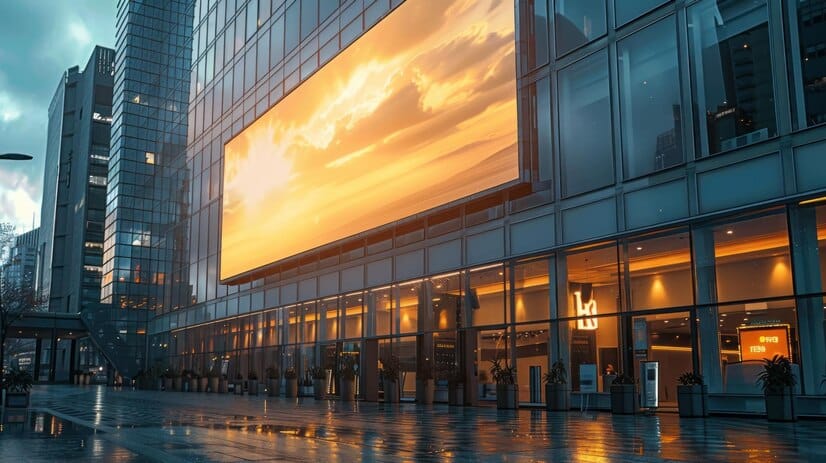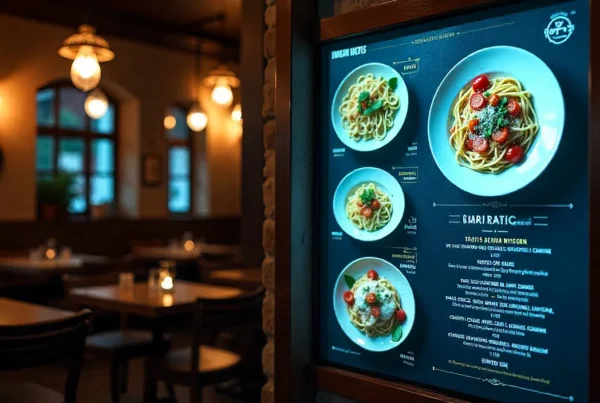As the current market is rather saturated and extremely competitive, companies are always looking for opportunities to grab people’s attention. Among the most recent trends creating a revolution in the advertising industry is the window advertising screen. These displays are installed on the external façade of the storefront, and they provide dynamic and compelling content that entices the target market as well as reminds the target market of the advertiser’s brands. From retail shops, restaurants, and formal working places, window advertisement screens are fast turning into indispensable tools for relaying information in the most creative and efficient ways possible.
This paper aims to understand what window advertising screens are, their advantages, how they differ from other signage, and their possibilities in the future for retail and advertising markets.
What is a window advertising screen?
The term window advertising screen is well understood as a digital screen or monitor placed on the inside of a storefront window or by the window facing the outside. These screens are intended to provide promotional information, messages, or interactive advertisements that may catch the attention of people within the vicinity. It can display videos or images, text, or animations for the purpose of advertisement of products, events, sales, and services in real-time.
Window advertising screens can vary in technology, size, and configuration.
• Transparent LED screens: They permit visualization to be rendered at the same time with the aid of the glass window but also allow projection.
• LCD or LED Panels: Large screens of high resolution that show bright images, which can be placed on the window or behind it.
• Interactive Touchscreens: Meant for customers to access, first, by touch, for product inquiries or just simply browsing.
• Projection-Based Displays: Certain screens use projector technology that displays ads on windows.
These screens are visible in the daytime and at night, making sure that the businesses get the most out of the space in terms of both pedestrian traffic and vehicular traffic.
Benefits of Window Advertising Screens
Window advertising screens are becoming increasingly popular because they are much more effective than conventional signs. Below are some key benefits:
1. High Visibility and Attention-Grabbing Appeal
Electronic content on screens is much more effective than printed material in the form of posters or banners. Bright colors, pictures, clips and other moving objects catch the eye and remind of the brand. This makes window advertising screens highly suitable for shops in areas that experience high traffic, such as groceries.
2. Dynamic and Real-Time Content
The key benefit of using window advertising screens is the feature of updating the displayed content in real-time. In a business setting, it is easy to change what is presented on the screen using cloud-based software in a matter of seconds depending on the message being sent, such as a flash sale, new arrivals, and events. This makes it possible to always have the content on the marketing sites relevant to the current trends and campaigns.
3. Cost-Efficiency and Sustainability
Cost-Efficiency and Sustainability are chosen as two important aspects to focus on when creating and designing products, services, and even organizations.
Although the initial investment in the establishment of a digital screen is higher than that of posters, window advertising screens help eliminate the costs of printing and disseminating posters. Also, they are more environmentally friendly than paper-based screens because the businesses can use the screen over and over again without the creation of paper waste.
4. Enhanced Brand Image
Contemporary, clear electronic signs are associated with innovation and professionalism of a brand. A thin digital screen provides a touch of class and gives customers a good first impression. Companies that use this technology stand to benefit from being associated with advanced technology.
5. Targeted and Time-Based Advertising
Window screens help the business to post content at specific times of the day or during a particular week. For instance, a café may post the breakfast offers during the morning while the evening offers during the evening. This approach is quite beneficial in that it assures the right message gets to the right audience at the right time.
Window Advertising Screens vs. Traditional Signage
Traditional signage such as posters, banners, and billboards has been used for decades. However, window advertising screens offer a new dimension to visual marketing. Below are some key differences:
| Feature | Window Advertising Screen | Traditional Signage |
| Content Type | Videos, animations, and real-time text | Static images and printed content |
| Update Speed | Instant (cloud-based updates) | It requires reprinting and redistributing |
| Environmental Impact | Eco-friendly (reusable) | High paper and material usage |
| Interaction Capability | Can be interactive (touch-enabled) | Non-interactive |
| Cost | Higher initial investment but fewer recurring costs | Lower setup cost but higher recurring expenses |
While traditional signage has its place, especially for specific brand aesthetics, the versatility and engagement offered by digital screens are driving a shift toward window-based advertising screens.
Use Cases of Window Advertising Screens
A wide range of industries are using window advertising screens as a means to meet their business goals and targets. Below are some popular use cases across different sectors:
1. Retail Stores
Window screens are employed to advertise product lines, campaigns, or the next sale. In connection with the increasing popularity of digital retail, physical stores must make their environment engaging, and window screens must successfully navigate between online and offline advertising campaigns.
2. Restaurants and Cafés
Restaurant windows can be easily used to put up changeable menus, daily specials or other promotional messages. Animated content of mouthwatering foods and drinks can lure people inside, especially in areas that are crowded.
3. Real Estate Offices
Real estate agents use advertising billboards on the shop windows to advertise properties, photos, prices, and videos. This makes it possible for the passers-by to see the properties with the available rooms without necessarily having to go to the office.
4. Service-Based Businesses
Banks, fitness centers, beauty salons, and other service providers are the main beneficiaries of the window screens because they display their services, membership plan or any other special offer. Other uses of screens include announcements such as holiday hours and changes in policies, among others.
Challenges and Considerations
Though there are many advantages of window advertising screens, they are not without some difficulties. Businesses need to consider the following factors:
• Initial Cost: The establishment of high-quality screens and the software that is needed may be costly. Although this is true, the cost of print material is saved in the long run by having a company website.
• Screen Brightness and Visibility: They have to be clear even when viewed from behind the computer screen, especially when the setting is outdoors. Some of the screens are incorporated with light sensors that cause changes in brightness depending on the surroundings.
• Maintenance: As with any technology, the technology inherent in digital screens needs to be constantly maintained to remain as efficient as possible. The display panels require some occasional wipedown, and the software needs updates for security or functionality.
• Power Consumption: Although energy-efficient models are attainable, the power usage should be closely observed to ensure the least cost and the best return on the environment.
Conclusion
Window advertising screens have therefore brought a dramatic change in how companies can market and sell their products. These screens blend the aesthetic of engaging digital content with management of placement to transform storefronts and commercial spaces into marketing assets. This way they give businesses a chance to remain relevant in today’s fast-paced market, as these features include real-time updates, interactivity, and eye-popping graphics. With future development, those advanced features like touch screens, intelligent recognition, and mobile device compatibility will amplify the effects of these screens. Finally, window advertising screens are not just advertising surfaces for products and services; they are opportunities for improvement in customer experiences, brands, and sales conversion. Any company that will be willing to incorporate this modern advertising solution will undoubtedly set themselves up for future success.





